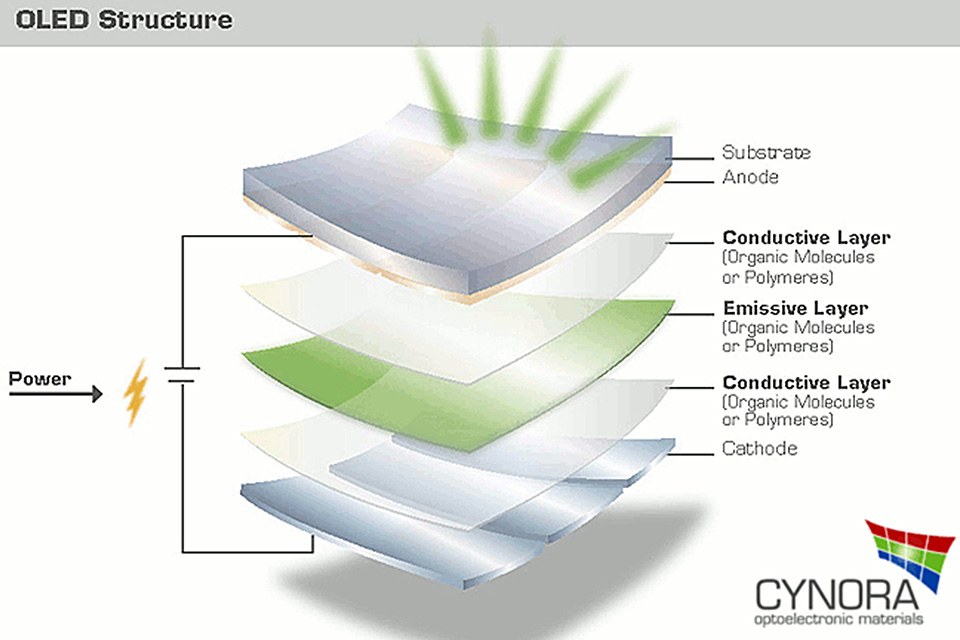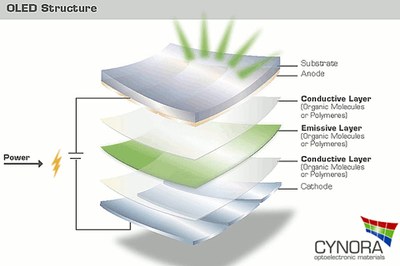Supported Project “cyCESH” for Cost‐Efficient Printed OLEDs
On June 1, 2013, BMBF launched the project cyCESH involving cynora GmbH, Novaled AG and the University of Regensburg with the workgroup of Prof. Dr. Hartmut Yersin. The project is set to run for a duration of three years with a total funding of 6.1 million euros. The research of new soluble materials for the inexpensive production of organic light emitting diodes (Organic Light‐Emitting Diodes ‐ OLEDs) and the production of OLED devices with high efficiency are the main focus of the project.
The new printable materials make it possible to manufacture OLEDs with simpler and cheaper printing processes. Currently conventional OLEDs are still mainly being produced by expensive vacuum processes.
“Through our collaboration with Novaled and Prof. Yersin of the University of Regensburg, we combine, within a team of experts, a comprehensive and specific know‐how and can take it to the next step in OLED development," said Dr. Thomas Baumann, Managing Director of cynora GmbH "our consortium strives for the overall goal of developing mass‐market materials and methods for production of OLEDs.”
The collaboration of these project partners guarantees an optimum coverage of the value chain. Combined together, the areas of material development (Prof. Yersin), the subsequent synthesis and optimization of the materials (cynora GmbH), as well as the application of solution‐based‐processed, doped transport layers (Novaled) form a complete comprehensive partnership for OLED applications.
About OLEDs:
OLEDs (organic light emitting diodes) are a few nanometers thick (little material) self‐radiating flat light ources, which are made of organic semiconductors (free of harmful substances). In an extremely fast growing market, OLEDs play a key roll in a revolutionary development: the realization of paper‐thin, flexible, highly efficient displays with brilliant colors and high contrast. Organic light emitting diodes are currently used as displays in a selection of smartphones, cameras and MP3 players. There is also a huge market potential in the field of lighting with visionary applications. For lighting applications, high color rendering index (CRI = 90) and a warm natural white light that is particularly pleasant to the eye. OLEDs have the potential to be more efficient than current energy‐saving light sources.
About cynora:
cynora GmbH was founded in 2003 and a new management team took over in 2008. The company focuses on the discovery of novel organic semiconductors, which due to their physical properties as emitting phosphors, will find an application in organic light diodes. From the design of new functional molecules for organic light‐emitting diodes, to their synthesis in the laboratory and to detailed testing of these materials through production of OLED components, cynora covers the full range of material and component development.
Besides exploring new ways of achieving additional efficiency gains, the young and dynamic team behind cynora, currently consisting of 20 people, also works on improving key aspects of OLED applications, such as cost‐effective processing and life expectancy. Printing optoelectronic components requires new, intelligent materials and approaches. Resulting products can be used as displays, light sources, design objects and for smart packaging.
For further information: www.cynora.com
About Novaled:
Novaled AG is a leader in the discovery, development and commercialization of technologies and materials that enhance the performance of organic light- emitting diodes (OLEDs) and other organic electronics. Novaled offers manufacturers of OLED‐products a unique combination of proprietary technology, materials and expertise. Novaled is currently the only company that also licenses and sells conductivity‐enhancing technology and organic materials for use in the mass production of OLED products. Novaled has developed long term partnerships with major OLED players. In addition, the company, with its more than 500 registered and pending patents in the field of OLED® technology, structures and materials, has a strong IP position. The company has been active in the market since 2003. It was founded in 2001 as a spin‐off from the Technical University of Dresden (IAPP) and the Fraunhofer Society (IPMS) in Dresden and has in addition to its headquarters in Dresden, offices in Korea and Japan.
For further information: www.novaled.com
About Prof. Dr. Hartmut Yersin, Universität Regensburg:
The research group of Prof. Yersin has been working for over three decades in the field of photophysical characterization and development of new emitter materials. For almost one and a half decades, the scientific and technological activities have focused on properties of OLED emitters and
their application. A total of over 210 scientific publications and 19 review articles in prestigious international journals, over 50 patents have been filed and seven books, including an OLED reference work, have been published. Over 35 articles and 47 patent applications have a direct reference to OLEDs.
For further information:
www.uni‐regensburg.de/Fakultaeten/nat_Fak_IV/Physikalische_Chemie/Yersin/


